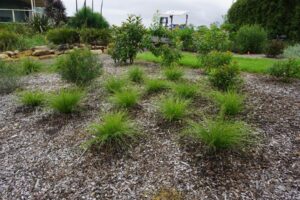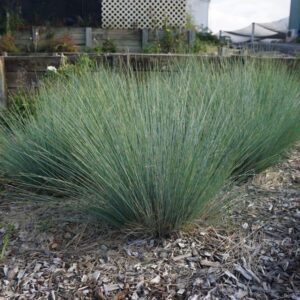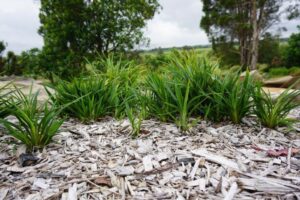
Native plants and grasses surveyed with Landscape Architects
By Daniel Fuller
Plant breeding has made significant strides over the past couple of decades. What once impressed landscape architects no longer suffices, as new cultivars are now more resilient, requiring less maintenance. While nursery businesses know what has sold well in the past, predicting future popular cultivars remains a challenge.
In the last issue of Hort Journal we discussed a poll shared with landscape architects through the Australian Institute of Landscape Architects (AILA), focusing on newly-bred ground covers and shrubs. This article dives into the new native strappy plants and grasses that they’re likely to specify as these plants become available through wholesale nurseries.
Tanika™ Lomandra has historically been one of the most popular Australian native plants ever to be specified in public landscapes. It’s amazing in dry conditions, however it has a weakness;- it doesn’t like wet feet. Lady Tanika™ Lomandra solves this problem, being able to tolerate both flooding and drought.

It’s a female plant that’s less attractive to ants, has clean foliage and self-cleaning flowers, and is a bit shorter and wider but every bit as low-maintenance as Tanika™ Lomandra. Landscape architects like this new cultivar because they can specify it for poor soils and can market their designs as “low maintenance.”
Evergreen Baby™ Lomandra is another low-maintenance strappy leaf plant that can tolerate both flooding and drought conditions. It has a mature height of 45cm so it doesn’t impact line of sight, and it’s also a perfect playground plant which landscape architects value.

Baby Breeze™ Dianella is about half the size of Breeze™ Dianella that re-shoots from rhizomes. It can even recover from being driven over, making it ideal for roadsides. Summer Rev™ Dianella has more upright, architectural foliage with clean, blue-toned foliage and has trialled well in wet conditions.
In terms of true grasses, two Poa species stand out. Eskdale Blue™ Poa grows quickly, establishing in just a couple of weeks, and within a year it has the appearance of a mature plant. It has attractive, blue-toned foliage that keeps its colour better than other species of Poa.

On the other hand, Rustic™ Poa embraces the browning foliage typical of the genus, being bred specifically for those brassy tones. It’s very much in fashion as the natural scrubby look is gaining momentum in landscape architecture. It’s 40% smaller than Eskdale Blue™ Poa and contrasts beautifully in specimen planting.
Having spoken to growers that are trialling our new plants, the feedback has been consistent – the new cultivars are much easier and faster to propagate through division and tissue culture. This has been a focus of our breeding for these new plants; to help provide enough stock to meet demand.
If you’d like to learn more about growing and selling these plants, look into our Ozbreed Easy Access (OEA) program for nurseries. Visit this webpage: https://www.ozbreed.com.au/ozbreed-easy-access/
Alternatively, email horticulture@ozbreed.com.au if you have any specific questions.
Daniel Fuller & Ozbreed
M: 042 6169 708
E: hello@plantsgrowhere.com
